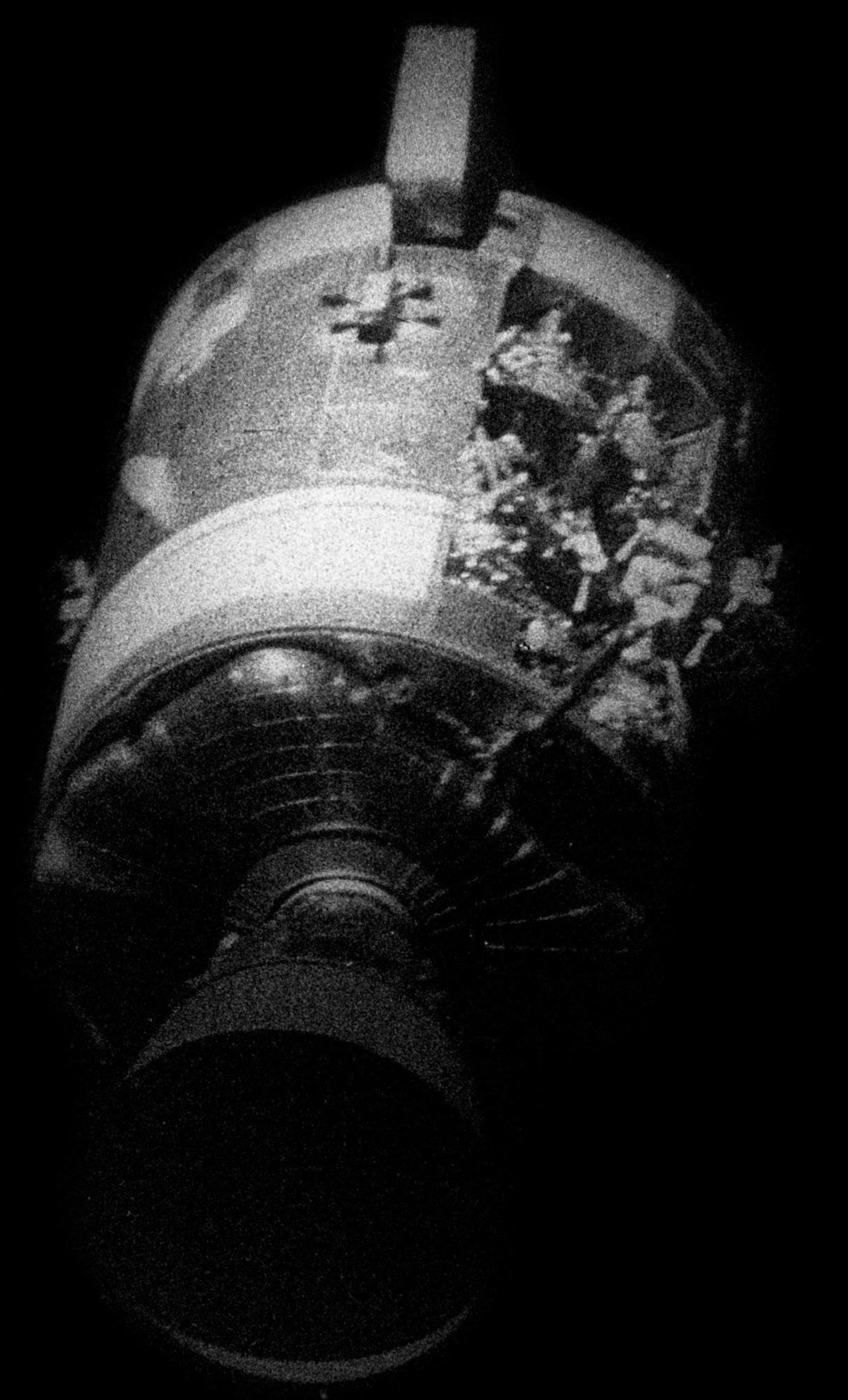
Figure 1: The damaged Apollo 13 service module, Odyssey, seen from the lunar module, Aquarius. Credit: NASA.
THE "SUCCESSFUL FAILURE" OF APOLLO 13, HALF A CENTURY LATER
The Apollo 13 mission was the fifth manned flight to the Moon and
the third lunar landing attempt. After the first two successful
test flights of Apollo 11 and Apollo 12 to the surface of the
Moon, the Apollo 13 mission was more scientific oriented, with
activities focused on geological and space physics experiments on
the lunar surface, in addition to rock and soil samples
retrieval. Moreover, mission objectives included the photography
of candidate exploration sites, as well as to develop capabilities
to work in the lunar environment. The landing site was selected to
be in the Fra Mauro formation, near the Fra Mauro crater, for it
was believed to contain impact material generated in the early
history of the Moon.
For a number of reasons, in the popular culture the number 13 has
been considered to be closely associated with luck; in some
countries it represents bad luck, whereas in ohers, is a good
omen. Superstition does not have any room in science and
technology, so the number 13 for that particular Apollo flight
just meant that it was the mission after Apollo 12. However, some
people felt a bit uneasy with the designated mission number. Half
a century after the historic flight of Apollo 13 everyone knows
what actually happened. The phrase "Houston, we have a problem"
became popular in modern culture, and the outcome of the mission
has finally been understood as the consequence of a number of
incidents, some of them even unnoticed, each one playing a part in
the chain of events that ended up with three astronauts struggling
to come back home alive. The happy ending of the mission was the
result of the hard work of many people on the ground and the three
astrounauts in their crippled spacecraft (Fig. 1), and not luck. Or wasn't
it?
Apollo 13 lifted-off from lauch pad 39-A at the Kennedy Space
Center in Florida on April 11th, 1970, at 14:13:00 EST, and its
accident happened on April 13th. You can start counting the number
of 13s in the previous sentence. From what it was publicly known
at that time, we can say that the mission oddly started even many
months before the launch. Orginally, the prime crew, composed by
Jim Lovell (CDR), Ken Mattingly (CMP) and Fred Haise (LMP), was
assigned to the Apollo 14 mission. The original Apollo 13 flight
had the crew composed by Alan Shepard (first US astronaut, and
CDR), Stu Roosa (CMP) and Ed Mitchell (Fig. 2). Shepard had been
grounded for several years due to Ménière's deseas,
and came back to flight status in 1968. Due to lack of proficiency
and to allow him to get better prepared for the mission, in 1969
NASA decided to switch crews with that of Apollo 14. After months
of training and only a week before the launch, the LMP of the
backup crew, Charlie Duke, contracted rubella. Due to close
proximity during training, all astronauts, from both prime
(Fig. 3) and backup crews, were tested for rubella immunity. One
of them, Ken Mattingly (Fig. 3), had never been exposed to the
desease, therefore, he was not immune. Normally, under these
circumstances, all three astronauts in the primary crew should
have been replaced by those in the backup crew. However, in this
particular case, Duke was part of the backup team which obligated
to replace Mattingly by his backup counterpart, Jack Swigert
(Fig. 4), only two days before the start of the mission, otherwise
all astronauts would have been bumped to a later flight. This
change in a crew with a such a short notice had never been done
before.
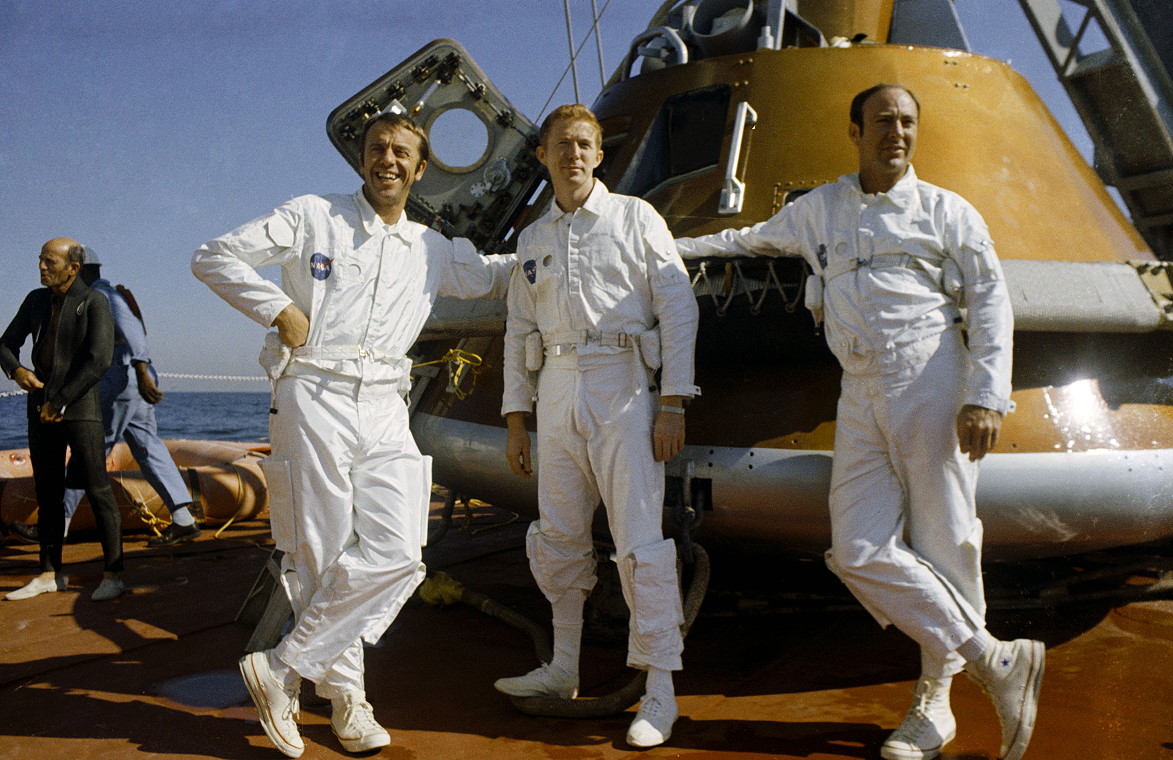
Figure 2: Original prime crew of the Apollo 13 mission. From left to right: Alan B. Shepard, Jr. (CDR), Stuart A. Roosa (CMP), and Edgar D. Mitchell (LMP). To allow for a better preparation, considering the lack of proficiency of the commander due to his several years being grounded, NASA decided to move this crew to the next Apollo mission, thus switching crews. Credit: NASA |
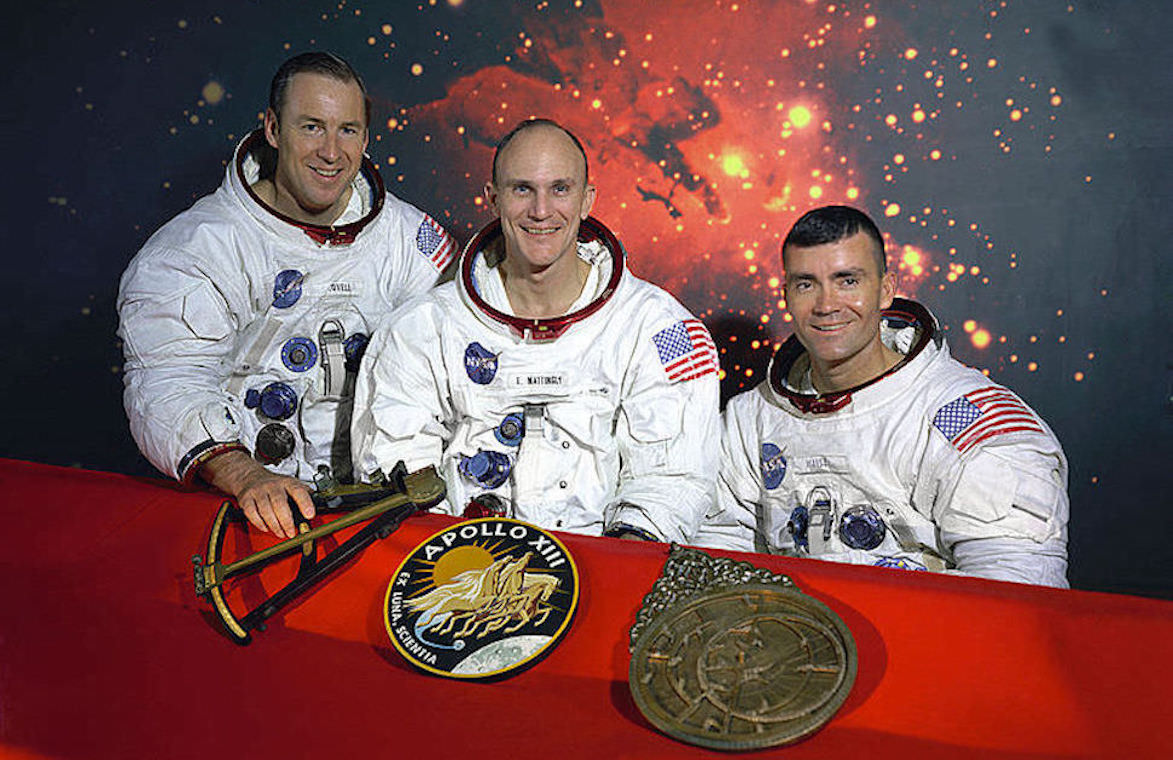
Figure 3: The new prime crew of the Apollo 13 mission. From left to right: James A. Lovell, Jr. (CDR), Thomas K. Mattingly II (CMP), and Fred W. Haise, Jr. (LMP). They had originally been selected for Apollo 14, but were reasigned to Apollo 13 to allow for more training time for Alan Shepard and his crew. Credit: NASA |
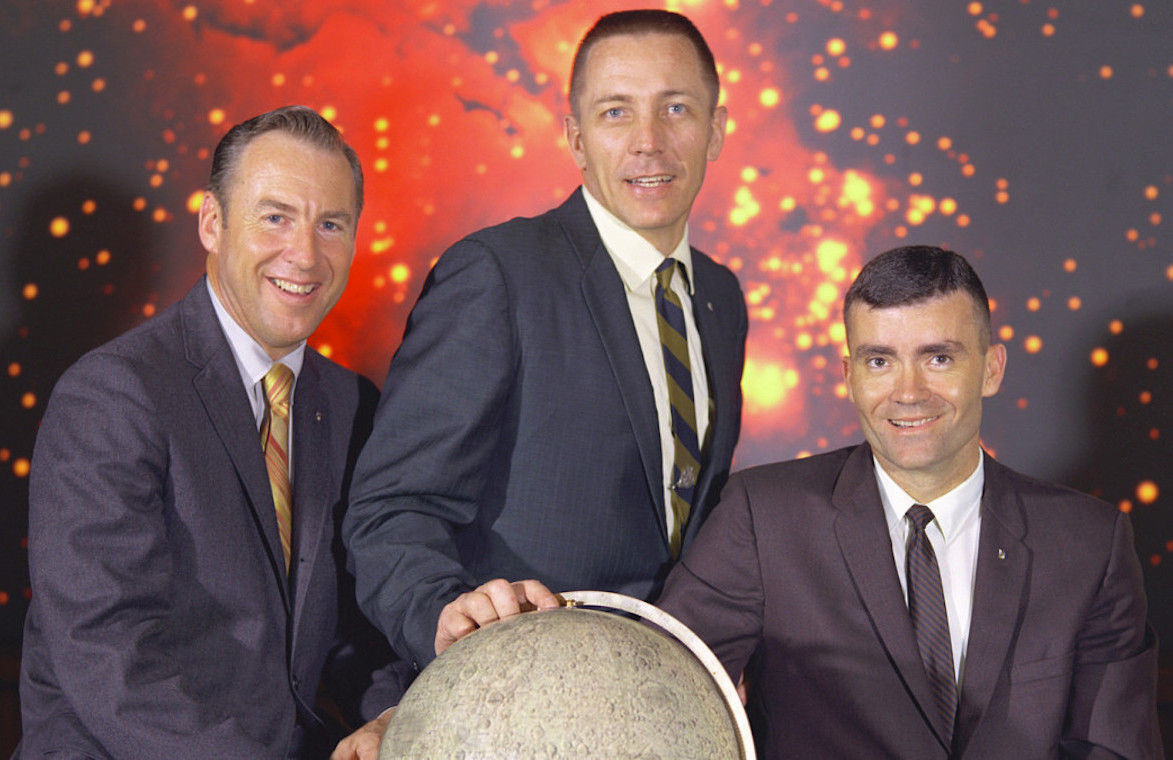
Figure 4: The final crew of Apollo 13 that made the flight. From left to right: James Lovell, John L. Swigert Jr. (CMP), and Fred Haise. Jack Swigert was a last-minute replacement, taken from the back-up crew, to Ken Mattingly who had been exposed to rubella, contracted by back-up crew LMP Charles M. Duke Jr., and did not have immunity through prior exposure as the rest of the prime crew. Credit: NASA |
The first two minutes of the mission were completely normal,
without a glitch. However, during the second stage boost, the
center engine of the S-II stage cut off about two minutes
early. The engine shut down was instructed by the vehicle's
guidance system due to a severe pogo oscillation detected. As a
result, the remaining four S-II engines burned 34 second longer,
and the S-IVB orbital incertion burn time was about 44 seconds
longer as well to compensate. Orbital incertion and trans-lunar
injection were successfully completed and the mission from there
on proceded normaly, except for an anomaly with the reading of the
quantity of liquid oxygen in tank No. 2 of the electrical power
system (EPS) in the Service Module (SM) of the spacecraft
(Fig. 5). At about 55 hours 55 minutes of ground elapsed time
(GET; 10:08 PM EST) the crew reports a main bus B undervoltage
condition following a large bang associated with it. The pressure
in oxygene tank No. 2 was lost rapidly, and the current generated
by fuel cells 1 and 3 droped to zero due to the loss of their
oxygen supply. After some moments, a decision was made to abort
the mission.
Postflight analyses revealed that the cause of the catastrophic
failure of the SM was set up more than a year before the mission,
without being noticed nor suspected. Was it indeed bad luck? A
series of unfortunate events led to the unsuccessful lunar landing
of Apollo 13, with the possible dead of the astronauts and the
likely cancellation of the Apollo program. All these events relate
to oxygen tank No. 2 of the EPS (Fig. 5). The first major one of
them happened in 1968 during preparations for the Apollo 10
mission. The EPS is composed by three fuel cells, two liquid
hydrogen tanks and two liquid oxygen tanks. Both oxygen tanks are
mounted on a shelf that is installed inside Sector 4 of the
SM. The oxygen assembly that was used for the Apollo 13 mission
had been first installed in SM 106 for the flight of Apollo
10.
Due to electromagnetic interference problems with the vac-ion
pumps on cryogenic tank domes in earlier Apollo spacecrafts, a
modification to solve that was introduced. A decision was made to
replace the complete oxygen shelf in SM 106 by one that already
had that modification. In the deinstalling process, due to a bolt
mistakenly left in place, the whole oxygen shelf was dropped about
two inches back into its original position. This incident caused
undue acceleration to the tanks, and photographs of the underside
of the fuel cell shelf indicated that the closeout cap on the dome
of oxygen tank No. 2 (Fig. 6) may have struck the underside of that
shelf. After this, the oxygen shelf was removed without
difficulty, visually inspected, and checked for self integrity. No
problems were detectd, although a loosely fitting fill tube could
have been displaced with the above incident. The tanks were
modified to prevent the interference problems. The shelf passed
the tests and was reinstalled in SM 109 (Apollo 13) in November
1968. The countdown demonstration test began in March 1970. During
this test, difficulties to empty -or detanking- oxygen tank No. 2
were encountered. In the following days, detanking operations with
tank No. 2 turned out to be difficult. It was considered as the
source of the problem a possible leak in the path between the fill
line (Fig. 6) and the quantity probe due to a loose fit. Perhaps the
dropping of the oxygen shelf in 1968 contributed to the loose fit
and the leak in the tank's fill line.
The detanking problems continued, and in order to empty tank No. 2
a decision was made to try to "boil off" the remaining oxygen by
using the tank's heaters (Fig. 6). The tank got empty after about 8 hours
of heater operation. And here there is a major issue that was
unintendedly ignored. The heaters were energized with the 65 V DC
power supply available on the ground. However, the original design
of the tank's heating system considered operation with the 28 V DC
spacecraft's power supply. Each heater was protected with a
thermostatic switch (Fig. 6) which was intented to open the heater circuit
when temperatures reached the 80 F. Test conducted after the
mission showed that such switch would become defective and unable
to open the circuit when working at the 65 V DC power. This
mulfunction, unknown at the time, may have caused the temperature
on the heater tube to rise to as much as 1,000 F during the
"special" detanking procedure. This high temperature caused serius
damage to the adjacent Teflon insulation, making wires inside the
tank to become exposed. While NASA had ordered the manufacturer of
the tanks to modify the switches to properly work at 65 V, this
modification was never performed. More filling tests were
conducted, and the detaking of tank No. 2 continued to be
problematic. The solution again was to use the heaters to remove
the excess oxygen. While extensive consideration was given to all
possibilities of damage from a loose fill tube, very little
attention was paid to the extended and repetitive operation of the
heaters and fans (Fig. 6) during detanking sequences. The latter was simply
not considered as potentially dangerous at the time. Since the
filling of the oxygen tank No. 2 always proved to be successful,
the leak of the fill line would not be a problem in flight. It was
finally decided to leave the oxygen shelf and tank No. 2 in the SM
and to proceed with preparations for launch of Apollo 13.
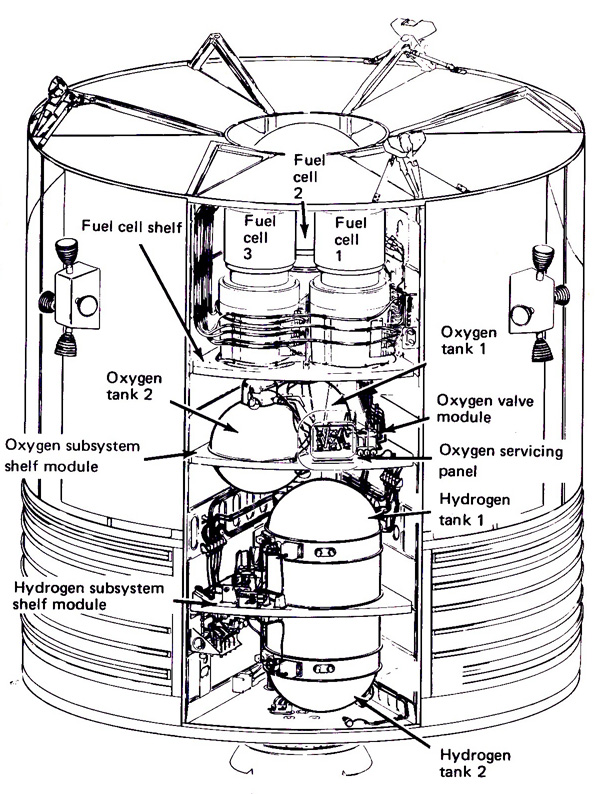
Figure 5: Diagram of the Apollo Spacecraft Service Module showing the location and configuration of the electrical power system (EPS) in Sector 4. EPS components include the 3 fuel cells, the 2 liquid hydrogen tanks, and the 2 liquid oxygen tanks. Oxygen tank No. 1 is located in the inner region of the sector, while oxygen tank No. 2 is located in the region further out. Credit: NASA |
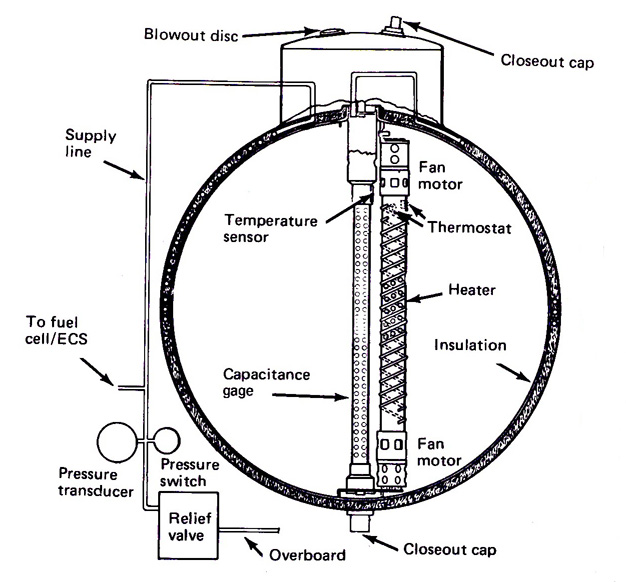
Figure 6: Diagram of the structure and different components of the oxygen tanks of the EPS. The heater and fan are energized simultanously, and the latter is used to stir-up the cryogenic oxygen in the tank to prevent its stratification and improve quantity level readings. The thermostat's function is that of preventing the temperature from rising to undesirable levels when using the heater. Credit: NASA |
Now we encounter another element of luck, which may have been, at
the end of the day, what saved the astronauts. Because of the
cryogenic temperatures in the oxygen tanks, liquid oxygen had to
be stirred to prevent stratification. The stratification of the
liquid oxygen would provide an inaccurate reading of the quantity
of oxygen remaining in the tank. This was the purpose of the fans
inside the tanks (Fig. 6) which would operate at the same time of the
heaters (Fig. 6). In previous Apollo missions the fans were turned on every
24 hours. During the first 46 hours of the mission the performance
of oxygen tank No. 2 was normal. However, at about 46 hours 40
minutes GET, after a routine stir of the oxygen tanks, the
quantity inside tank No. 2 went from the normal reading of about
82% full to an incorrect reading of over 100%. This issue may have
been caused by a short circuit in the electrical wiring of the
quantity gage. To better analyze the situation, Mission Control
chose to perform two more stirings of tank No. 2, one at about 47
hours 55 minutes GET and another one at about 51 hours 08 minutes
GET which showed off-scale high readings with no apparent adverse
effects. A decision had been made to increase the frequency of the
heater-cryo-stirs, going from the nomal once every 24 hours to
once every 6 hours to help the reading of the gage. After
veryfication procedures of the Lunar Module were completed, and
before the next rest period of the crew, Mission Control requested
a fifth stir of both oxygen tanks No. 1 and No. 2, following an
indication of low pressure in tank No. 1, at about 55 hours 53
minuted GET. This last heater-cryo-stir was immediately followed
by an explosion of tank No. 2 and the main bus B undervoltage
condition reported by the crew. The rest is history.
The cause of the explosion was due to exposed wires inside tank
No. 2 (Fig. 5 and Fig. 6) that, upon activation of the fan-heater
system, created an arc that ignited the oxygen inside the
tank. The explosion at least partially destroyed tank No. 2 and
damaged tank No. 1 (Fig. 5) causing a leak in it. The excess pressure
created inside Sector 4 of the SM due to leakage and additional
burning caused by the loss of integrity of tank No. 2 blew off the
corresponding outside panel of the SM (Fig. 1). Those exposed wires were
the result of the extended and repetitive operation of the heaters
on the ground with thermostats functioning at a higher voltage
than that they had been manufactured for. And here is when the
apparent bad luck of Apollo 13 may have been indeed a good one!
Oxygen tank No. 2 explosion occured with the fifth cryo-stir. This
means that, due to the unknown damage to the fan-heater system's
wires, the explosion was going to happen anyways at the fifth use
of that system. At a rate of one cryo-stir approximately every 24
hours, had not the quantity gage in tank No. 2 malfunctioned, the
complete failure of the tank would have occured at about 120 hours
GET. This means that the explosion in the SM would have occurred
after the first EVA on the Moon, with Lovell and Haise on the
lunar surface before a second EVA. They would have received an
urgent call from either Mission Control or Jack Swigert in the CSM
informing about the accident. Swigert's assessment of the
situation and problem would have been very difficult without the
help of his mission companions in the orbiting
spacecraft. Moreover, the periodic interruption of
telecommunications with Mission Control every time the CSM went
behing the Moon would have added even more problems. Once the real
magnitude and nature of the failure had become aparent, the EPS
would no longer be producing oxygen, water and electrical power
inside the CSM. The stay on the lunar surface would have been
aborted, but with a crippled spacecraft and without the descent
stage of the Lunar Module available as main propulsion system, all
three astronauts would have died stranded in lunar orbit.
Now, let's consider another element of luck. The tank that exploded
was oxygen tank No. 2, located further away from the inside of the
SM Sector (Fig. 5). This meant that most of the energy of the explosion was
released toward the outside of the spacecraft, thus blowing off
the external panel (Fig. 1). Had tank No. 1 (Fig. 5) been the one being hit during
removal from SM 106, the one with detanking issues (that required
untested procedures), the one with the problem in the quantity
probe, and ultimately that one that exploded, in that case most of
the energy would have been released inside the SM, probably
causing also tank No. 2 to explode and hence increasing the power
of the explosion. Likely, the whole SM would have exploded perhaps
with the Command Module as well, terminating with the mission and
the life of the astronauts. Even more, if we consider the timing
of the explosion itself, this may have been another element of
luck, and a good one. Had the explosion occurred earlier than it
did, before the fifth activation of the heater-fan system,
something quite possible with exposed electrical wires powered in
an environment full of pressurized oxygen, the very diminished
supplies available in the spacecraft would have been totaly
consumed before having completed the return trajectory back to
Earth and around the Moon. The return trip would have been too
long and the crew would have perished on the way back due to lack
of oxygen. Now, one would think, why not immediately returning
back to Earth, why having to go around the Moon? Although the
possibility of an abort and immediate return to Earth was
considered in every mission, this manoeuvre, specially that close
to Earth, required the fully operational propulsion system of the
CSM. Because of the explosion, the safest assumption was to
consider that propulsion system as inoperative due to a potential
major damage. Igniting the main engine would have been too
risky. The lower power of the descent engine of the Lunar Module
was insufficient to successfully accomplish such a drastic
manoeuvre. Therefore, the only viable option was that of going
around the Moon, a trip just long enough to keep the astronauts
alive.
So in the end, the luck of Apollo 13 may have been a good one
after all. In fact, the quantity probe malfunction, something that
had nothing to do with electrical wires without insulation and
which was not expected at all, may have led to the "successful
failure" of Apollo 13. This problem prompted Mission Control to
instruct the use of the heaters and fans in the oxygen tanks more
often than normal which caused the explosion just at the right
time in GET that enough residual power, water, electricity and
oxygen would be available in the lunar lander to reach the Earth
with the crew alive. Had not this malfunction presented itself,
then the Apollo 13's story and that of the rest of the Apollo
program may have been very different. That's luck!, don't you
think?
References:
"Management
Lessons of the Moon Program" by Andrew Chaikin, Goddard Space
Flight Center Knowledge Management Workshop (July 2012)
Apollo 13, from
Wikipedia, and references therein
Report
of Apollo 13 Review Board, NASA (June 1970)
(PDF version)
"50
Years Ago: Apollo 13 Passes Countdown Test" by Kelli Mars
(Editor), NASA History (March 2020)
"13
Things that Saved Apollo 13" by Nancy Atkinson, Universe Today
(April 2010)
"Why
didn't Apollo 13 just turn around when the oxygen tank exploded?"
by C. Stuart Hardwick, Quora (February 2019)
-April, 2020. (Last revised: July 2020)


